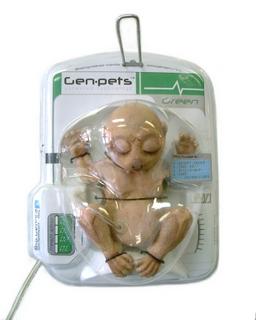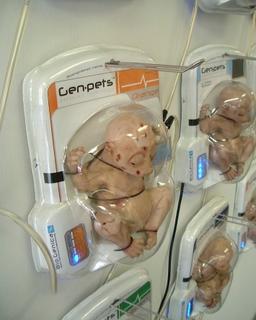 Seven years ago, author-economist Jeremy Rifkin worked to set up a "genetic conservancy": he and cell biologist Dr. Stuart Newman submitted a first-of-its-kind patent to the US Patent Office that included "thirty claims covering all the human-animal chimeras (human-chimpanzee chimeras, human-pig and other combinations) for medical purposes." The intent was "to forbid any researcher from crossing human-animal boundaries with embryonic cells for twenty years so that countries can have the time to debate this issue and hopefully pass the appropriate legislation to outlaw all transgenic organisms." Congress paid little attention to the issue of chimera, and scientists forged onward both here (including a U of MN experiment that circulated human blood in pigs) and abroad (Chinese scientists successfully fused human cells with rabbit eggs in 2003). At last, the US Senate is considering a bill to ban human chimera.
Seven years ago, author-economist Jeremy Rifkin worked to set up a "genetic conservancy": he and cell biologist Dr. Stuart Newman submitted a first-of-its-kind patent to the US Patent Office that included "thirty claims covering all the human-animal chimeras (human-chimpanzee chimeras, human-pig and other combinations) for medical purposes." The intent was "to forbid any researcher from crossing human-animal boundaries with embryonic cells for twenty years so that countries can have the time to debate this issue and hopefully pass the appropriate legislation to outlaw all transgenic organisms." Congress paid little attention to the issue of chimera, and scientists forged onward both here (including a U of MN experiment that circulated human blood in pigs) and abroad (Chinese scientists successfully fused human cells with rabbit eggs in 2003). At last, the US Senate is considering a bill to ban human chimera. Unlike these slow-footed senators, artists—from the Critical Art Ensemble to Minerva Cuevas to Eduardo Kac (whose infamous "trangenic art" project was a fluorescent-green glowing bunny)—have long been questioning the wisdom of tinkering with the genetic blueprints of life.

Now Canadian sculptor Adam Brandejs enters the fray with a creepy new project that speaks directly to the issue of chimera—and the ghoulish engineering, packaging and commodification of living things. Called Gen-Pets, his installation consists of 19 animatronic creatures fabricated out of foam and other materials and encased in plastic store-display containers.

Part of his artist's statement:
Today, we are well within the process of desensitizing an upcoming generation towards accepting bioengineering as “natural”. This generation is slowly and systematically being desensitized towards owning and manipulating life through toys such as Tamagotchis, and Furbies. If we do not raise questions as too where this technology can lead us and catch them before it is too late, there will be no turning back. I want people to second think the choices they make before purchasing these types of toys or gadgets.(Via We Make Money Not Art.)
My goal is not to ask such questions as, how will we relate to this new engineered life? How will it fit into our lives and us into theirs? You can see in my work that I already have this answer. I fear that we will completely objectify living matter, and that we’ll treat them the exact same way we treat Cellphones, Gameboys, and every other consumable (technological) commodity that has been marketed to us. The real question then becomes, not how we will relate to genetically grown life, but how will we relate to all other life after that? How will we interact with life, once we have been taught to think of it as just one more disposable commodity?
No comments:
Post a Comment